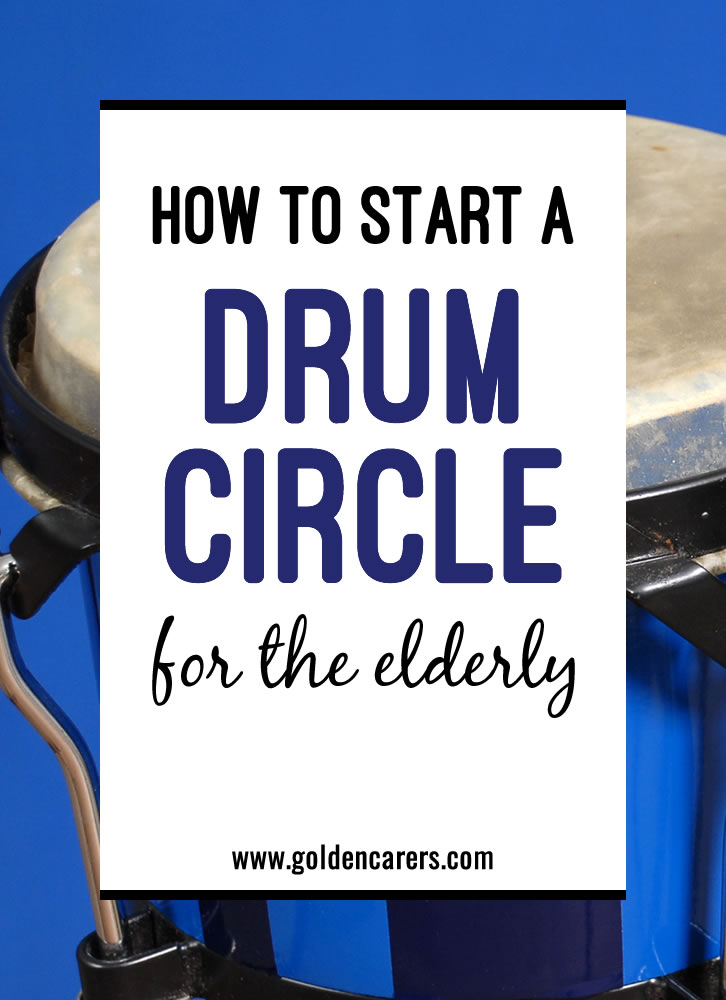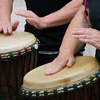
Golden Carers has 1000s of activities and resources for senior care.
Drums are among the oldest form of musical instruments. Every culture has a history of drums to accompany war cries, manhood rituals, solstice gatherings, marriage ceremonies, harvest, and more.
In recent years, drumming has become increasingly popular in the Western World via Drum Circles. A Drum Circle, as the name suggests, is a circle of people, each with a drum or another percussion instrument and one facilitator to lead the group. The practice of group drumming extends to nursing homes, hospices, schools, hospitals. It is suitable for any age group.
You could hire a licensed Drum Facilitator or a Music Therapist to lead a class and instruct staff on how to facilitate a session. However, the absence of a Music Therapist should not stop you from organizing a Drum Circle session yourself. It is an entertaining and harmless activity well worth pursuing.
This article is geared towards Activity Coordinators and other activity staff. It does not encompass all there is to know about drumming; it simply provides some basic information, with some examples on how to conduct a Drum Circle session.
Benefits of a Drum Circle
- Improve social cohesion
- Reduce tension, anxiety and negative feelings
- Induce alpha brain waves which make you feel calm and relaxed
- Incite laughter and good humour
- Maintain clients in the present moment (mindfulness)
- Generate positive energy
What you need to start a Drum Circle
Good equipment is very important. Despite not being able to give advice on how to buy drums, here are some drum timbres (quality of sound) needed for best results:
- Bongos, small djembes – middle sound
- Buffalo drums and djembes – bass
- Ocean drum and thunder tube – natural sounds
- Shakers (a few)
Drums can be rather expensive but most facilities already have some available. Any percussion instrument is suitable for a Drum Circle. You may also hire drums or borrow them from local libraries.
How to Facilitate a Drum Circle
For further understanding watch these videos prior to the session, and use what you deem suitable for your clients.
Drum facilitators, as far as I know, have no official governing body. That means anyone with enough enthusiasm can read a few books and watch a few YouTube videos and then go on to host a successful drum session.
If you would rather be trained as a facilitator, there are groups and companies offering these services; talk to your management regarding costs.
Group drumming is not about teaching people how to drum; it is simply allowing the group to express themselves for personal empowerment and wellness. This is especially important in the first session when freedom and encouragement is the name of the game.
Remember, most clients can drum even if they have never drummed before. We instinctively possess a sense of rhythm: we can tap our feet, our hearts beat, we use a rhythm to walk, we dance to a rhythm. The facilitator will guide the group to discover the rhythm that’s already within them.
A Drum Circle should be informal, entertaining, and satisfying. The session’s duration depends on the dynamics of the group; between 40 minutes to one hour is a good length of time to aim for. There are many ways to make a Drum Circle fun and exciting. The following is just one example.
Drum Circle Activity Plan
Introduction and Warm-Up
- Organise the circle assisting clients to sit comfortably.
- Introduce yourself, thank clients for coming. Say a few words regarding drumming through the ages with one or two paragraphs (example below).
- Create and practice a STOP signal to stop the drumming; otherwise you will have a hoarse voice at the end of the session. You can make up any stop signal - for example, place your arms in front of you with both hands facing down and touching each other. Separate hands in a horizontal line as fast as possible, to indicate – STOP!
- Explain to clients that when you lift both hands up it means play LOUDLY and vice-versa; when you lower both hands they should play SOFT.LY
- Practice with one client; seat participant in the middle of group with a drum or percussion instrument. Practice STOP – LOUD – SOFT and FAST and SLOW (by beating fast and slow) a few times.
- Then, assist clients to choose a drum or give each a drum or other percussion instrument.
- Ask participants to practice (to relax into the activity) as they like. No need to instruct or show how, when, or what to play. Just let them jam away!
- Practice the STOP signal and LOUD, SOFT, FAST and SLOW a few times with the group.
Start Session
- Facilitator stands in the middle of the circle and beats a pattern with a drum e.g. tap drum twice, and one by one each participant repeats the beat.
- When everyone in the circle has had a turn, repeat with the whole group drumming together.
- Facilitator does this for a minute and then changes the tempo to FAST and SLOW then LOUD and SOFT for the group to repeat, and so forth…
- Then, change the pattern two or three times. Ask clients for patterns ideas and have the group to repeat after him/her.
Drum Patterns
- Military Drums: 6 fast beats …pause… and 2 beats, repeat
- Ball Rumble: Bounce the ball for drums to repeat
Vocal patterns
Instead of tapping the drum you may vocalize the patterns. Always start slowly and when everybody gets it, speed up. Below are some examples of vocalised patterns to try, you can also make up your own.
Facilitator vocalizes the beat three or four times for participants to follow.
| Toot pah pah pah… toot pah pah pah… toot pah pah pah… And so on, then change loud soft fast and slow Or: chicka chicka boom… chicka chicka boom… chicka chicka boom… and repeat as above |
Ask participants to create their own vocalized beats for the group to follow.
Sentence Patterns
Sentence patterns are another fun way to use the drums.
- Find a sentence and say to the group: ‘If you were to beat the rhythm for this sentence, how would it go?” ‘I march to the beat of my own drum’ – who would like to try to drum this sentence?
- The participant (hope for a brave volunteer!) beats the sentence a couple of times and the group follows him. Facilitator joins in and changes tempo and volume as above.
- If no volunteers eventuate facilitator will say: Let’s try with me, slowly: I march (2 beats) – to the beat (three beats) – of my own drum (four beats). Again!
- And away you go, followed by the change in tempo and volume.
Be aware that if a participant is trying to beat a sentence, it is a matter of taste and perception how he accents the beat. There is no right or wrong way of beating the drums; everything is valid.
Creating Sentences
Ask clients: “When you are angry how would you express it on the drums? Play on the drum how you might feel.” Continue asking clients for sentences to be expressed in beats. Encourage them to come up with their own.
Expressing sentences is usually popular and the facilitator may stay there for a while. If not, here are some examples:
I’m not drunk I’m sober! – 3 beats for - I’m-not-drunk and 2 beats for I’m-sober
Don’t bother me! – 1 beat - Don’t and 3 beats for bo-ther-me
Shut the garage door – 5 beats - Shut-the-ga-rage-door
Bouncing pizza - 4 beats – boun-cing pi-zza
Start slow, find the rhythm and speed. Ask participants for nonsensical phrases.
Ending the Session
- Don’t have expectations on the outcome of the session, Drum Circles usually ebb and flow. It is alright to provide rhythms and beat sentences, but let it flow on its own as well.
- Wind down the session when interest wanes.
- Thank, and acknowledge participants and invite them for another session in the future.
- Document the group’s behavioural and psychosocial responses: alertness, level of interaction, satisfaction, connection, enjoyment, cooperation.
- Remember the focus is on laughter, wellbeing, and building social cohesion.
We'd love to hear your feedback!
Related Activities
Comments Post a Comment

 25th Apr 2017
Recreational Therapist
25th Apr 2017
Recreational Therapist
I apolgoize for the late response. We used laundry baskets for the dollar store, but a carboard box would also work if you have them around your building!

 25th Apr 2017
Recreational Therapist
25th Apr 2017
Recreational Therapist
 29th Apr 2017
Activities Assistant
29th Apr 2017
Activities Assistant

 12th Apr 2017
Recreational Therapist
12th Apr 2017
Recreational Therapist
 12th Apr 2017
Activities Assistant
12th Apr 2017
Activities Assistant
 12th Apr 2017
12th Apr 2017


 Activities for the Baby Boomer Generation
Activities for the Baby Boomer Generation
 The Role of Guest Speakers in Residential Care
The Role of Guest Speakers in Residential Care
 How to manage Wandering Behaviour
How to manage Wandering Behaviour
 11 Things Every Activity Professional Should Have In Their Office
11 Things Every Activity Professional Should Have In Their Office



It's a wonderful idea; we have now started our drum circle. Like most of us the cost of
drums is way over the top so we decided to use empty large coffee tins with
the plastic top also Pringles crisps containers which also have the plastic top. These are
great for the ladies just to tap. They have decorated them themselves with ordinary gift
or crepe paper, what ever is available. Everyone has a great deal of fun and they
decided they liked to drum to 'she wears red feathers' and one or two other songs. The
drum sticks we made out of wooden batons and chop sticks, infact anything available at
the time. We dress up, ladies with beautiful head dresses and the men with a fez. Very
cheap from Amazon. Many many thanks for this wonderful idea.